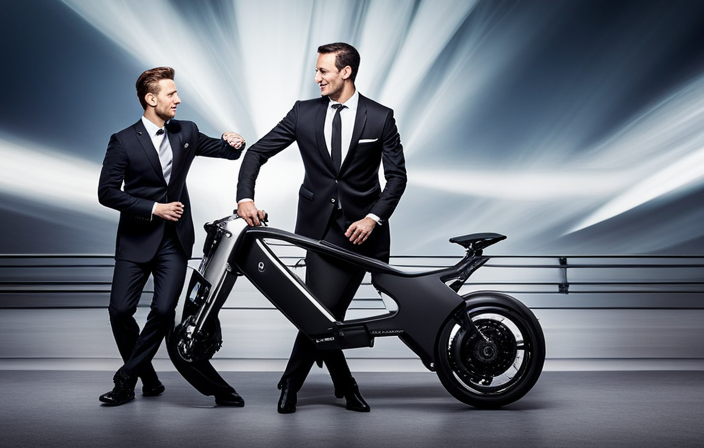Is your electric bike in need of a refreshing spa day?
Get ready to bring back that shiny, brand-new feel as you learn the expert techniques of washing your electric bike.
Picture yourself standing outside, hose in hand, as you gently rinse away the dirt and grime that has accumulated on your trusty two-wheeler.
With a mild soap or bike cleaner, and a soft brush or sponge, you’ll scrub away any stubborn residue.
So, let’s dive in and discover the step-by-step process to keep your electric bike looking and performing at its best.
Key Takeaways
- Properly drying components and applying lubrication is essential for preventing damage and ensuring smooth operation of the bike.
- Storing the electric bike in a safe and protected location is important to avoid rust, corrosion, and damage to electrical components.
- Protecting against moisture is crucial to prevent rust, corrosion, and maintain optimal bike performance.
- Considering the impact of extreme temperatures and avoiding storage in extreme heat or cold is necessary to protect battery life and maintain proper bike functionality.
Gather the necessary cleaning supplies
You’ll need to gather the necessary cleaning supplies before you can start washing your electric bike. To begin, grab a bucket, a hose, and a soft-bristle brush. The bucket will be used for mixing cleaning solution and carrying water. Opt for a mild detergent or bike-specific cleaner to prevent any damage to the bike’s components.
Additionally, grab a microfiber cloth or sponge for wiping down the frame and components. A hose with adjustable pressure will come in handy for rinsing off the bike. Don’t forget to gather some degreaser for cleaning the drivetrain and a lubricant for afterwards.
Once you have all the supplies, you’ll be ready to move on to preparing your electric bike for washing by following these steps…
Preparing your electric bike for washing
First, make sure your e-bike is turned off and disconnected from any power source before starting the washing process. This is crucial to ensure your safety and prevent any electrical mishaps.
Begin by inspecting your bike for any loose or damaged parts that may require repair or replacement before washing. Cover sensitive areas such as the battery, motor, and display with plastic bags or waterproof covers to protect them from water damage. Additionally, remove any accessories like lights or mirrors that may be easily damaged during the cleaning process.
By preparing your electric bike in this manner, you can prevent potential damage and ensure a smooth and effective washing experience.
Now, let’s move on to the next step, starting with a gentle rinse.
Start with a gentle rinse
To begin, turn on the hose and spray water gently over your e-bike, ensuring a thorough rinse of any dirt or debris. Start at the top and work your way down, making sure to cover every nook and cranny. The water pressure should be enough to remove any loose particles without causing damage to the bike’s electrical components.
Pay extra attention to areas like the chain, gears, and brakes, as these tend to accumulate more grime.
Once you’ve rinsed off the surface dirt, it’s time to move on to the next step – using a mild soap or bike cleaner. This will help to break down any stubborn dirt or grease and leave your electric bike looking clean and shiny.
Use a mild soap or bike cleaner
After rinsing your e-bike, it’s time to apply a mild soap or bike cleaner to remove stubborn dirt and grease. This step is crucial in maintaining the cleanliness and longevity of your electric bike.
Here are four reasons why using a mild soap or bike cleaner is essential:
-
Efficient cleaning: A mild soap or bike cleaner is specifically formulated to break down dirt and grease, ensuring a thorough cleaning of your e-bike.
-
Protects the finish: Using the right cleaner helps preserve the paint and coating on your bike, preventing any damage or fading caused by harsh chemicals.
-
Safe for components: Mild soaps and bike cleaners are gentle on the bike’s components, ensuring that they remain in optimal condition without any corrosion or deterioration.
-
Environmentally friendly: Many bike cleaners are eco-friendly, meaning they are biodegradable and won’t harm the environment.
Now that your e-bike is soaped up, you can move on to the next step and scrub gently with a soft brush or sponge.
Scrub gently with a soft brush or sponge
Once you’ve soaped up your e-bike, gently scrub it with a soft brush or sponge to remove any remaining dirt or grime. Be sure to use a brush or sponge with soft bristles to avoid scratching the surface of your bike.
Start at the top and work your way down, paying close attention to areas that are prone to dirt buildup, such as the chain, gears, and wheels. Take extra care when scrubbing around delicate components like the display screen or charging port.
To make this process even more effective, you can use a table to keep track of the different areas of your bike and ensure you don’t miss any spots. Remember to rinse your brush or sponge frequently to avoid spreading dirt around.
Now, let’s move on to the next section and discuss how to pay attention to the electrical components of your e-bike.
Pay attention to the electrical components
Make sure you’re gentle when cleaning the electrical components, as they can be sensitive to water and harsh scrubbing. The electrical components of an electric bike are crucial for its proper functioning, so it’s important to handle them with care during cleaning.
Start by inspecting the components for any dirt or debris. Use a soft brush or sponge to gently remove the dirt, making sure not to apply too much pressure. Avoid using excessive water, as it can damage the electrical parts. Instead, dampen the brush or sponge with a small amount of water or a mild cleaning solution specifically designed for electronics.
Clean the components by lightly brushing or wiping them, taking care not to get any water or cleaning solution into the sensitive areas such as connectors or cables. After cleaning, rinse thoroughly to remove all soap residue, ensuring that no cleaning solution is left behind that could potentially damage the electrical components.
Rinse thoroughly to remove all soap residue
Be sure to thoroughly rinse the components to remove any soap residue that may be left behind. After washing your electric bike, it is crucial to rinse it properly to ensure the removal of all soap residue.
Soap residue can be detrimental to the electrical components of your bike, causing damage or malfunction. To rinse the bike, use a gentle stream of water from a hose or a bucket. Ensure that all areas, including hard-to-reach places, are thoroughly rinsed. Pay close attention to the battery compartment, motor, and any electrical connections.
Make sure there is no soap residue left behind, as it can lead to corrosion and electrical issues. Once all the components are rinsed, you can move on to the next step of properly drying your electric bike.
Dry your electric bike properly
To ensure proper drying, use a soft cloth or towel to gently wipe down all the components of your electric bike. Start with the frame, wiping away any remaining moisture or dirt. Pay close attention to hard-to-reach areas such as the bottom bracket and headset.
Next, move on to the wheels, making sure to dry the rims, spokes, and hubs thoroughly. Don’t forget to dry the brake calipers, ensuring they are free from water or debris that could affect their performance.
Take the time to wipe down the handlebars, stem, and seat post, removing any moisture that may have accumulated.
Once all the components are dry, it’s time to apply lubrication to the chain and other moving parts.
Apply lubrication to the chain and other moving parts
You’ll want to use a lubricant to ensure the chain and other moving parts of your bike are properly lubricated.
Lubrication is essential for maintaining the smooth operation of your electric bike and prolonging its lifespan.
When applying lubricant, start by cleaning the chain and other parts with a degreaser to remove any dirt or debris.
Once cleaned, apply the lubricant evenly along the chain, making sure to penetrate the links thoroughly.
You can use a lubricating spray or a drip bottle for precise application.
After applying the lubricant, give it some time to penetrate and then wipe off any excess.
This will prevent attracting dirt and ensure a clean and efficient operation.
Now, let’s move on to the next section on how to store your electric bike in a safe and dry place.
Store your electric bike in a safe and dry place
Now that you’ve properly lubricated the chain and other moving parts of your electric bike, it’s crucial to store it in a safe and dry place. This is essential to ensure the longevity and optimal performance of your bike.
When choosing a storage location, consider a space that’s protected from the elements, such as rain, snow, and excessive humidity. Moisture can lead to rust and corrosion, which can damage the electrical components of your bike. Additionally, avoid areas with extreme temperatures as they can also impact the battery life and overall functionality of your electric bike.
If possible, store your bike indoors, in a garage, or a dedicated bike storage area. Make sure to keep it away from any chemicals or substances that may be harmful to the bike’s frame or electrical system.
Conclusion
Now that you’ve learned how to wash your electric bike, you’re equipped with the knowledge to keep it clean and in optimal condition.
By following these simple steps and using the right cleaning supplies, you can ensure that your bike stays free from dirt, grime, and residue.
Remember to rinse thoroughly, scrub gently, and dry your bike properly to prevent any damage.
With regular maintenance and proper storage, your electric bike will continue to provide you with a smooth and enjoyable ride for years to come.









